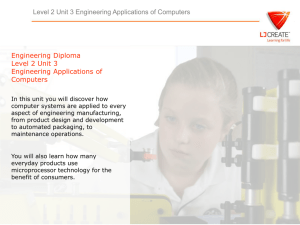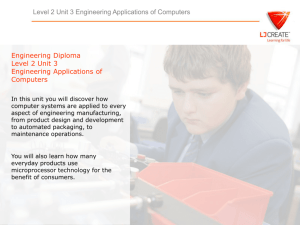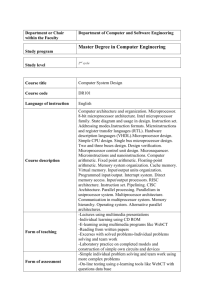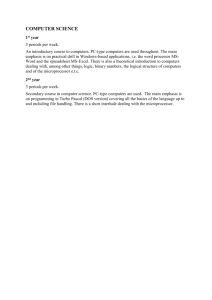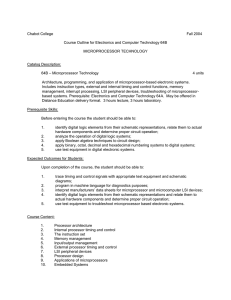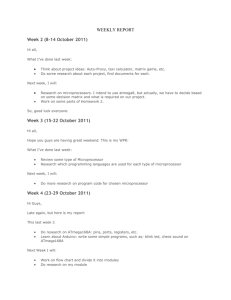THE QUALITY IMPROVEMENT OF MICROPROCESSOR COURSE VIA COMPETENCY-BASED MODULE LEARNING
advertisement
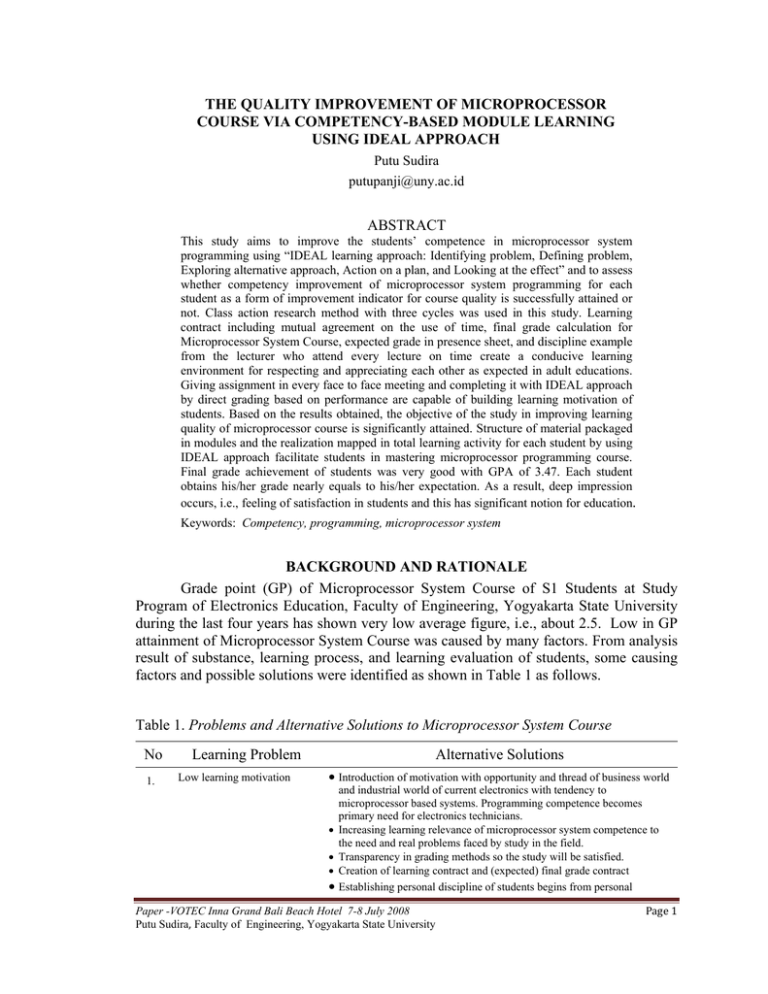
THE QUALITY IMPROVEMENT OF MICROPROCESSOR COURSE VIA COMPETENCY-BASED MODULE LEARNING USING IDEAL APPROACH Putu Sudira putupanji@uny.ac.id ABSTRACT This study aims to improve the students’ competence in microprocessor system programming using “IDEAL learning approach: Identifying problem, Defining problem, Exploring alternative approach, Action on a plan, and Looking at the effect” and to assess whether competency improvement of microprocessor system programming for each student as a form of improvement indicator for course quality is successfully attained or not. Class action research method with three cycles was used in this study. Learning contract including mutual agreement on the use of time, final grade calculation for Microprocessor System Course, expected grade in presence sheet, and discipline example from the lecturer who attend every lecture on time create a conducive learning environment for respecting and appreciating each other as expected in adult educations. Giving assignment in every face to face meeting and completing it with IDEAL approach by direct grading based on performance are capable of building learning motivation of students. Based on the results obtained, the objective of the study in improving learning quality of microprocessor course is significantly attained. Structure of material packaged in modules and the realization mapped in total learning activity for each student by using IDEAL approach facilitate students in mastering microprocessor programming course. Final grade achievement of students was very good with GPA of 3.47. Each student obtains his/her grade nearly equals to his/her expectation. As a result, deep impression occurs, i.e., feeling of satisfaction in students and this has significant notion for education. Keywords: Competency, programming, microprocessor system BACKGROUND AND RATIONALE Grade point (GP) of Microprocessor System Course of S1 Students at Study Program of Electronics Education, Faculty of Engineering, Yogyakarta State University during the last four years has shown very low average figure, i.e., about 2.5. Low in GP attainment of Microprocessor System Course was caused by many factors. From analysis result of substance, learning process, and learning evaluation of students, some causing factors and possible solutions were identified as shown in Table 1 as follows. Table 1. Problems and Alternative Solutions to Microprocessor System Course No 1. Learning Problem Low learning motivation Alternative Solutions • Introduction of motivation with opportunity and thread of business world and industrial world of current electronics with tendency to microprocessor based systems. Programming competence becomes primary need for electronics technicians. • Increasing learning relevance of microprocessor system competence to the need and real problems faced by study in the field. • Transparency in grading methods so the study will be satisfied. • Creation of learning contract and (expected) final grade contract • Establishing personal discipline of students begins from personal Paper -VOTEC Inna Grand Bali Beach Hotel 7-8 July 2008 Putu Sudira, Faculty of Engineering, Yogyakarta State University Page 1 No Learning Problem Alternative Solutions discipline of the lecturer. 2. 3. 4. 5. 6. 7. 8. 9. Minimum learning resources • Supply of handouts/modules/slides/textbooks, Internet Low mastery in microprocessor system concept Low mastery in microprocessor architecture. Low mastery of microprocessor set instructions Low mastery in programming algorithms. Low capability in identifying programming problems. Low capability in identifying problems, developing algorithms and flow charts. Low capability in writing and testing programs. • Discussion, group job assignment, test, remedial, tutorial. • Supply of examples, discussion, analysis of instruction process, test, • remedial, tutorial, group assignment. Supply of examples, discussion, analysis of instruction process, test, remedial, assignment, tutorial. • Supply of examples, discussion, analysis of problem, test, remedial, programming assignment. • Supply of case examples, group assignment, and personal assignment, tutorials. • Supply of case examples, group assignment, and personal assignment. • Exercise in programming case in groups or individual. Microprocessor Systems Course emphasizes on building programming competence in assembly language. Developing competence in microprocessor system program requires mastery in microprocessor system architecture. Douglas (1992) formulates that developing programming competence requires capability in identifying interface parts, problem definition, representation of working program, proper choosing of instructions and program writing (p.212). One cannot automatically write a program without understanding the problem to solve with a program (Sudira, 2002,p.14). A program is arrangements of some instructions representing a solving function or solving problems. Therefore, before a program is written, problem of the program should be identified and defined clearly first, various possibilities are elaborated as alternatives for problem solving approaches. Proper algorithm and flowchart will represent a working program. Proper use of instructions and program writing become a final part for a compute program creation. Douglas formula on competency development of programming is in line with the approach of Identifying problem, Defining problem, Exploring alternative approach, Action on a plan, and Looking at the effect, abbreviated as “IDEAL”. IDEAL approach is a problem based learning approach model (Anik Gufron, 2003). IDEAL (Identify, Define, Explore, Act, Look) a kind of problem solving methodology. AIMS AND OBJECTIVES This study was carried out to improve learning quality of Microprocessor Systems Course. Besides, it is also aimed at creating the structure of material and grading standard of Microprocessor Systems Course to increase the attainment of microprocessor system programming, class management model to carry out competency based module learning by using IDEAL approach. Besides, this study was carried out to increase the presence of students with good grade qualification (B) to excellent qualification (A) from 38.42% to 75%. Paper -VOTEC Inna Grand Bali Beach Hotel 7-8 July 2008 Putu Sudira, Faculty of Engineering, Yogyakarta State University Page 2 The prime objectives of this study are: 1. To increase students’ competence in microprocessor system programming by using an IDEAL learning approach. 2. To decide whether competency increase of the course for each student is attained or not. LITERATURE REVIEW In formulating competency based learning approach strategy, Bartridge (2006,p.2) suggests that the program structure should be standard based on the policy, objective of training result should be clearly described, and every thing is communicated to all participants, trainer and supporter of the training activity. The trainer should be responsible to the success/failure of the training. The training participant should be tested his/her skill related to job or plan of their competency development. The trainer should give enough time for the students to do their exercises. The trainer should be consistent in on job to be fully completed. Bartridge also suggests that competency based learning refers to the competency improvement that is productive, safe, more efficient, and more efficient in every job done. Competency based learning contains 12 characteristics, i.e.: (1) Learning focus on mastery of competency; (2) Specific learning objectives; (3) Learning emphasis on performance; (4) Individual nature of learning; (5) Multimode interaction, active participants, problem solving and contextual; (6) Teacher as facilitator; (7) Individual need orientation; (8) Direct feedback; (9) Using modules; (10) Field/practical learning; (11) Student centered; and (12) Objective grading criteria (PAP, grading based on standard). If the learning is based on competency based learning principles, then the benefits include: (1) Give more freedom to students to develop their skills at their own pace based on their capability; (2) Enable students to become more responsible to their own study progress; (3) Motivate and activate students in directing their attention to assignments. Motivation is determined by need underlying student objective and become a tool for productive behavior towards expected objectives. Performance is a result of interaction between motivation and ability known as expectancy theory. Therefore, someone with high motivation but low ability will produce low performance. In contrary, someone with high capability but low motivation will produce low performance. To produce high performance, someone should have high motivation and capability, but if someone has low motivation, then his/her performance will be low too. To measure or asses performance, the main problem is how to decide the criteria. To evaluate performance some major requirements include: (1) performance criteria for objective measurement; (2) objectivity in evaluation process. In this case, there are three different evaluation criteria: (1) performance evaluation based on result; (2) performance evaluation based on behavior; (3) performance evaluation based on judgment. In evaluating students’ performance, some agreed criteria should be created first. It is stated that performance assessment is realized based on four main assumptions, i.e.: (1) performance assessment based on active participation of students; (2) assignment Paper -VOTEC Inna Grand Bali Beach Hotel 7-8 July 2008 Putu Sudira, Faculty of Engineering, Yogyakarta State University Page 3 given or done by the students as integral part of the whole learning process; (3) assessment that is not only for examining student position in learning, but also for improving learning process; (4) by knowing in advance criteria used for measuring and assessing learning process, students will actively and openly try to achieve the learning objectives. Principally, there are two parts of assessment, i.e.: task and criteria. Performance tasks can be a project, exhibition, portfolio, or assignments asking students to show their capability in handling complex situations by applying knowledge and skill about something in realistic form. Meanwhile, criteria or rubrics are a guidance to score that is clear and agreed by lecturer and students. Therefore, the students can clearly try to improve or complete their performance. METHOD The study uses class action research method. The whole action research activities were done in three cycles, i.e.: Pre-action cycle, Cycle I action, and Cycle II action. The study has been carried out in Electronics Education Department, Faculty of Engineering, Yogyakarta State University, at second semester, from February to May 2007. The subjects include 32 S-1 students of Electronics Education Study program, Faculty of Engineering, Yogyakarta State University, who took Microprocessor System Course. Instruments used in developing and improving learning quality include: (1) Stop watch of NOKIA 6610; (2) Complete modules with case study and keys; (3) Mid term examination questions; and (4) Final Semester Examination Questions. Development and improvement of learning quality use descriptive qualitative data analysis. RESULTS Pre-action Cycle Discussion with research team produced an agreement that Microprocessor Systems Course is carried out in 4 x 50 minutes of laboratory activities and 2 x 50 minutes of theoretical face to face activities, and paper and laboratory report independent assignment. Instruction was divided into theoretical class A for 32 students, whereas laboratory classes were divided into two groups, i.e., A1 and A2 each with 16 students. Laboratory works include competency of microprocessor programming skill whereas theoretical material includes competency of microprocessor system programming concepts. Theoretical material should transform from "what-is” gap into “what-ought-to-be” or how programming competence should be developed. The sequence of competency completion in laboratory works and in theoretical class was mapped in Figure 1 and Figure 2 as follows: Paper -VOTEC Inna Grand Bali Beach Hotel 7-8 July 2008 Putu Sudira, Faculty of Engineering, Yogyakarta State University Page 4 L1: L5 L3 L1 L7 L L8 L6 L4 Applying Concept of Algorithms and Flowcharts in programming. L2: OperatingTrainer MPF-I L3: Programming Arithmatic Cases L4: Programming Data Processing and Number conversion cases L5: Programming Monitor Display Output Applications L6: Programming Keypad Input Applications L7: Programming Voice Output Applications L8: Programming PIO Figure 1. Laboratory Work Competency Achievement Map T1: T2 T1 T3 T4 T6 T5 T8 T7 Describing Microprocessor, Microprocessor systems, History and its Development T2: Describing Microprocessor Architecture T3: Describing Microprocessor System Architecture T4: Describing Number System in Microprocessor Systems T5: Understanding Instruction Set Microprocessor Zilog Z-80 CPU T6: Understanding Memory Unit Development T7: Understanding IO Unit Development T8: Understanding Microprocessor Assembly Figure 2. Theoretical Competency Achievement Map Cycle I Learning contract and discussion on programming problem was done. In learning contract, every student should make final grade achievement target of microprocessor system course. From 32 students, 2 students wanted grade B+, three students wanted graded A-, and 27 students wanted grade A. In acclamation, it was agreed that students should present in every activity as scheduled and granted for grade if their minimum attendance was 75%. Grading component include assignment (15%), mid semester test (15%), semester test (20%), daily laboratory test (10%), and report of laboratory work (40%). For student whose attendance was 100%, they got additional reward of 2 points. Laboratory work report was individually made in electronic file and submitted at most one week before semester test was done. In Cycle I, it is obtained that all students are able to complete all cases well and fast in average time. Figure 3 shows a chart of completing time of programming cases. Paper -VOTEC Inna Grand Bali Beach Hotel 7-8 July 2008 Putu Sudira, Faculty of Engineering, Yogyakarta State University Page 5 100% 90% 80% 70% slowly 60% medium 50% 40% fast 30% verry fast 20% 10% 0% 1 2 3 4 5 Fig gure 3. Time Percentage of Completiing Time of Programmin P ng Cases Notes: 1. Data transfer 2. 8 bit additionn 3. 8 bit subtractiion 4. 166 bit addition 5. Deecimal data genneration 00 to 99 9 For 8 bit additionn programmiing case, aboout 75% of the student need longerr time because the algorithm a is harder thann the one forr data transffer. In 8 bit subtraction case, abbout 35% of o the studennts are very fast in com mpleting the case becauuse subtractiion is innverse of ad ddition that the t case wass done in preevious weekk. In 16 bit addition, a aveerage acchievement is moderatte whereas for data generation g c case is fastt and very fast. R Responding to t course maaterial, classs managemennt, and assesssment, studdents’ responnse is depicted in Fiigure 4. 100% 90% 80% 70% 60% Neggatif response 50% Posiitive response 40% 30% 20% 10% 0% 1 2 3 Figurre 4. Studentts’ response on course material, m classs handling, and assessm ment Paaper -VOTEC In nna Grand Bali Beach B Hotel 7-88 July 2008 Puutu Sudira, Facu ulty of Engineering, Yogyakartaa State Universityy Page 6 N Notes: 1. 2. 3. Students’ ressponse on courrse material Students’ ressponse on class managementt Students' ressponse on assessment nts’ responsse on course material, cllass managem ment, and asssessment iss very Studen positive. Theere is satisfa faction in sttudent on course materrial, class management, m , and asssessment. Cycle III D During Cyclee II, improvvement of weaknesses w fo found in Cyccle II was done, d i.e., stuudent errrors in developing algorithm, flow chartt, and insttruction choice. Algorrithm development was still coonstrained by students’ thinking habbit from higgh level intoo low leevel. In flow w chart desiggn, there aree many studeent who inaccurate in chhoosing stanndard grraphical form ms. The choice of type and a form of instruction i iss also inaccuurate. Final semester asssessment off Microproceessor System ms Course of o S-1 Studeent of E Electronics Education E S Study Progrram, FT, UNY U of 20005 group inn academic year 2006/2007 caan be seen att a chart in Figure F 5 as foollows. 2006/20 007 B B++ 38% % A 16% 9% % B‐‐ C+ 0% % 0% A‐ 37% C D 0 0% 0% g distribution of Microprocess M sor Systemss Course off S-1 Figure 5. Final grade Studentts of Electronics Education of 2005 group durinng academicc year 2006/20007 s whoo obtain graade A, 37% obtain gradee A-; 38% obtain o Theree are 9% of students d 16% obtaiin grade B. Grade G trend pattern of thhe course tennds to be in good grrade B+, and reegion (B) to very extrem mely good (A A). From final grade of their exppectation duuring learninng contract and a real grade or fiinal grade achievement a t of the couurse, Figure 6 is givenn as followss. There aree five sttudents who obtain grade as targetedd, a student obtains o over target gradee, and 26 stuudents obbtain below targeted graade. Target grade g is expeected grade with maxim mum value off “A” ass motivator for their stuudy. Their chhoice of exppected grade of A and AA give first grade g Paaper -VOTEC In nna Grand Bali Beach B Hotel 7-88 July 2008 Puutu Sudira, Facu ulty of Engineering, Yogyakartaa State Universityy Page 7 motivation with very high influence and significance in their instructional activities. Most of the students who are unsuccessful to obtain target grade fall in good (B), more than good (B+), to very good (A-), i.e., all of which are in good quality range. 100 80 60 result 40 expectation 20 0 1 2 3 4 5 6 7 8 9 10 11 12 13 14 15 16 17 18 19 20 21 22 23 24 25 26 27 28 29 30 31 32 Figure 6. Area Pattern Distribution of Final grade of Microprocessor Systems Course of S-1 Students of Electronics Education of 2005 group during academic year 2006/2007 Grade point average (GPA) of Microprocessor Systems Course of the students from academic year 2002/2003 to 2006/2007 can be seen at Figure 7. During the last three years, the GPA improves from 2.33 to 2.93 and, in 2006/2007, it significantly improves to 3.47. Grade Point (GP) 4 3.5 3 2.5 2 1.5 1 0.5 0 Grade Point (GP) Figure 7. Graphical distribution of Grade Point of Microprocessor Systems Course of the students from academic year 2002/2003 to 2006/2007. Paper -VOTEC Inna Grand Bali Beach Hotel 7-8 July 2008 Putu Sudira, Faculty of Engineering, Yogyakarta State University Page 8 DISCUSSION Instruction as the main core in educational process has complex and dynamic quality. At macro level, achievement in instruction quality should become a professional responsibility of a lecturer by creating meaningful learning experience for students and by developing maximum learning resources facilities. In instruction, it is important to create change for the person who learns (Suyanto, 2006,p.). Experience is an important factor of learning because change occurring in a learning person caused by his/her own deep experience is very significant. To create innovative and creative students, instruction with relevant experience is strongly required. Experience inclusion in a lecturing process should be intentionally planned in structured actions. Class action research has been proven to be able to increase learning motivation of students. According to Gagne (1975), as cited by Suyanto (2006), it stated that good learning process should begin with motivation (p.95). Creating open learning contract related to mutual rights and obligation between lecturer and students, and assigning programming case with direct and continuous evaluation give very big influence on increasing learning motivation of the students. Achievement of assessment result published openly causes the students to compete to be the best. Their need in programming competence is formed and grows because they are aware of opportunity and thread of electronics business and industrial world which trend is to programmable based system. These expectations, as noted by Suyanto, are caused by good motivation in the beginning of the lecture. After motivation exists, the next step is to grow expectation in studying (Suyanto, 2006,p.89). Giving assignment, discussion, test based on performance, supplying competency modules may increase the lecturing quality of Microprocessor Systems Course. With enough practice, programming assignment, and discussion, the students will be able to further learn the concept of microprocessor system, microprocessor architecture, and microprocessor instruction set to improve competence in microprocessor system programming. The pattern of IDEAL approach in every programming case solution may significantly improve the microprocessor programming quality of the students. Ability to identify and define a problem, to develop algorithm and flowchart are basic capability for a programmer in creating and developing a program. After algorithm and flowchart are properly prepared, writing program in assembly language requires ability in choosing proper instructions, and then the program is created and tested with micro computer MPF-1 as proofing test to see the real truth of the result. Learning contract creation in the beginning of the lecture gives positive impact for helping the student in planning. Planning capability is instrumentally very important for students in developing their ability in using resources, communicating, cooperating, using data and information, and problem solving. The students begin to create target based on opportunity, manage their own strengths and weaknesses. Fail to plan means plan to fail. Learning contract should begin at KRS filling step with academic supervisor. Writing expected grade into attendance sheet can become social control among students because it is always seen each time they sign the sheet. Paper -VOTEC Inna Grand Bali Beach Hotel 7-8 July 2008 Putu Sudira, Faculty of Engineering, Yogyakarta State University Page 9 Supply of module learning resource may very effectively create better students learning capacity. Instructional approach using modules, exercises, independent assignments developed with IDEAL approach gives opportunity for them to independently learn based on each learning pace. Instruction with module system may create (1) wholeness and completeness of competency mastery, (2) continuation in learning process, (3) efficiency in the use of educational resources. CONCLUSION As a whole, the goal to increase the percentage of student number who obtains grade range from B to A with minimum percentage of 75% is perfectly achieved. S1 students of electronics education of 2005 entry year, in academic year 2006/2007, all of them (100%) obtained grade between B to A for Microprocessor Systems Course. GPA is 3.47, grade distribution is B, B+, A-, and A as shown in Figure 5. Nearly all students attain grade target expected in learning contract (Figure 6). Compared to grade achievement obtained in previous years, the achievement in this study is far better including its average that is very good. There is an increase in GPA from 2.93 in 2005/2006 to 3.47 in 2006/2007 (Figure 7). Reference Asmawi. (2001). Alternative Assesment. Jakarta: Proyek Pengembangan Universitas Terbuka Dirjen Dikti Depdiknas. Anik Ghufron, dkk. (2003). Pelatihan Pengembangan Model Pemebelajaran“Pemecahan Masalah“ Secara Kreatif Dalam mata Pelajaran IPS guru-guru SD se Kab. Sleman: Laporan Kegiatan PPM Bartridge (2006) Manager's role in a competency-based T&D system : tersedia pada http://www.reproline.jhu.edu/english/6read/ 6training/cbt/cbt.htm. diakses pada tanggal 11 Juli 2006 Depdikbud. (1995). Kamus Besar Bahasa Indonesia. Jakarta: Balai Pustaka. Depdikbud. (2004). Standar Kompetensi Nasional Bidang Otomasi Elektronika . Jakarta: Bagian Proyek Sistim Pengembangan Sertifikasi dan Standar Profesi Pustaka. Douglas. (1992). Microprocessor and Interfacing and Hardware. MCGraw-Hill Doppelt, J. (2005). Assesment of Project-Based Learning in a Mechatronics, Journal of Technology Education FX. Sudarsono. 2001. Apikasi Penelitian Tindakan Kelas. Jakarta : Pusat Antar Universitas Untuk Peningkatan dan Pengembangan Aktivitas Instruksional Dirjen Dikti Depdiknas. Kerka, Sandra. (1997). Constructivism, Workplace Lerning, and Vocational Education, ERIC Clearinghouse on Adult career and Vocational Education, tersedia pada http://www.ericdigests.org/1998-1/learning.htm diakses pada tanggal 15 Oktober 2007. Suyanto. (2006). Di Belantara Pendidikan Bermoral. Yogyakarta: UNY Press Paper -VOTEC Inna Grand Bali Beach Hotel 7-8 July 2008 Putu Sudira, Faculty of Engineering, Yogyakarta State University Page 10
